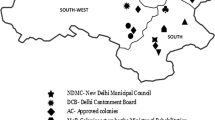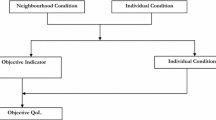Abstract
The quality of life is a fundamental aspect of development and advancement of human societies. However, measuring and expressing the quality of life in any given setting has proved difficult because it includes multiple dimensions. Further, methods based on questionnaire surveys have to contend with responses that are inexact and difficult to quantify. Here I estimate the quality of life of people living in the Indian city of Delhi using fuzzy sets theory, an approach that is designed to handle inexact or ‘fuzzy’ outcomes. Using a stratified random sample set of 330 households, I compare different locations in Delhi based on their access to seven basic services that is assumed to depict the quality of life. I found that the majority of services (in particular, the overall maintenance and transport services) are poor in resettlement colonies, unauthorised colonies, and urbanised villages. The quality of services improves in colonies under the jurisdiction of the Delhi Cantonment Board, the New Delhi Municipal Council, and approved colonies of the Delhi Development Authority. The overall patterns suggest that the differences in satisfaction and access are primarily influenced by location, and within each location they are influenced by economic conditions. Over 36 % of Delhi’s households, which are classified as ‘definitely poor’ and ‘extremely vulnerable’, may be deprived of transport services, around 44 % are deprived of overall maintenance services and over 29 % lack well-maintained green spaces in their neighbourhood. The analysis should draw the attention of policymakers on spatial aspects of development planning.



Similar content being viewed by others
Notes
http://articles.timesofindia.indiatimes.com/2011-12-06/india/30481060_1_migrants-upper-castes-urban-population. Accessed on 5 December, 2012.
http://www.census2011.co.in/census/state/delhi.html. Accessed on 10 December, 2012.
http://www.delhi.gov.in/wps/wcm/connect/Lib_Development/development/home/units+of+the+department/rural+development. Accessed on 10 December, 2012.
The NCT of Delhi now has five local Municipal Corporations: North Delhi Municipal Corporation, South Delhi Municipal Corporation, East Delhi Municipal Corporation, New Delhi Municipal Council and Delhi Cantonment Board. The former Municipal Corporation of Delhi was recently trifurcated into three smaller Municipal Corporations: North Delhi, South Delhi and East Delhi.
Partial correlations between each pair of variables controlling for the effects of all other variables were first checked and Kaiser’s measure of sampling adequacy was computed. The overall measure for the sample amounted to 0.89 which is well above what is considered as acceptable.
A rule of thumb frequently used in factor analysis, but can be adjusted depending on the number of variables and sample size. In this case with 330 observations, factor loadings of 0.30 are considered significant where significance is based on 5 per cent level of significance and standard errors assumed to be twice those of conventional correlation coefficients.
The area scale has 5 dichotomous variables. The reliability coefficient for this scale is 0.61, which is low when compared to the widely used rule of thumb of 0.70; however, the scale is still retained in the analysis.
Both the dwellings’ scales together have 9 dichotomous indicators. The reliability coefficients for these scales are 0.64 and 0.57, respectively. Though both the values are low, especially the 0.57 is lower when compared to the widely used rule of thumb of 0.70; the scales are still considered acceptable.
References
Bonaiuto, M., et al. (1999). Multidimensional perception of residential environment quality and neighbourhood attachment in the urban environment. Journal of Environmental Psychology, 19, 331–352.
Ceroli, A., & Zani, S. (1990). A fuzzy approach to the measurement of poverty. In C. Dagum, & M. Zenga (Ed.), Income and wealth distribution, inequality and poverty (pp. 271–284). Berlin: Springer.
Cheli, B., & Lemmi, A. (1995). A “totally” fuzzy and relative approach to the multidimensional analysis of poverty. Economic Notes by Monte dei Paschi di Siena, 24(1), 115–134.
Chiappero-Martinetti, E. (2000). A multidimensional assessment of well-being based on Sen’s functioning approach. Rivista Internazionale di Scienze Sociali, 108(2), 207–239. Available online http://www-3.unipv.it/cds/userfiles/file/Papers/paper_chiappero_1.pdf.
Cicerchia, A. (1996). Indicators for the measurement of the quality of urban life: What is the appropriate territorial dimension. Social Indicators Research, 39, 321–358.
Diener, Ed, & Suh, E. (1997). Measuring quality of life: Economic, social and subjective indicators. Social Indicators Research, 40, 189–216.
Directorate of Census Operations. (1991). Delhi: A Portrait of Population. Series-31. Census of India, Delhi.
Directorate of Census Operations. (2011). NCT of Delhi Profile. Provisional Population Totals, Census of India. New Delhi. Available online http://censusindia.gov.in/2011census/censusinfodashboard/stock/profiles/en/IND007_NCT%20of%20Delhi.pdf.
Dissart, J. C., & Deller, S. C. (2000). Quality of life in the planning literature. Journal of Planning Literature, 15, 135–161.
Dubois, J.-L., & Rousseau, S. (2008). Reinforcing households’ capabilities as a way to reduce vulnerability and prevent poverty in equitable terms. In F. Comim, M. Qizilbash, & S. Alkire (Eds.), The capability approach: Concepts, measures and applications (pp. 421–436). Cambridge: Cambridge University Press.
Filippone, A., Cheli, B., & D’Agostino, A. (2001). Addressing the interpretation and the aggregation problems in totally fuzzy and relative poverty measures. Institute for Social & Economic Research, Working paper no. 2001–22. Essex.
Government of NCT of Delhi. (2006). Economic survey of Delhi 2005–2006. New Delhi: Planning Department.
Government of NCT of Delhi. (2009). Economic survey of Delhi 2008–2009. New Delhi: Planning Department.
Lelli, S. (2001). Factor analysis vs fuzzy sets theory: Assessing the influence of different techniques on Sen’s functioning approach. Discussions Paper Series 01.21. Center for Economic Studies. Katholieke Universiteit Leuven. Available Online http://www.econ.kuleuven.be/eng/ew/discussionpapers/Dps01/Dps0121.pdf.
McCrea, R., Shyy, T. K., & Stimson, R. (2006). What is the strength of the link between objective and subjective indicators of urban quality of life? Applied Research in Quality of Life, 1, 79–96.
Michalos, A. C., & Zumbo, B. D. (1997). Public services and the quality of life. Social Indicators Research, 48, 125–156.
Musschenga, A. W. (1997). The relation between concepts of quality of life. Journal of Medicine and Philosophy, 22(1), 11–28.
Pacione, M. (2003). Urban environmental quality and human wellbeing—a social geographical perspective. Landscape and Urban Planning, 65, 19–30.
Planning Commission. (2009). Delhi Development Report. New Delhi: Academic Foundation.
Qizilbash, M. (2002). A note on the measurement of poverty and vulnerability in the South African context. Journal of International Development, 14, 757–772.
Raj, B. (1961). Census of India 1961. Volume XIX, Delhi. Superintendent of Census Operations. Government of India. Delhi.
Raj, B., & Sehgal, K. C. (1961). General Report on the Census. Volume XIX—Delhi. Part-I. Census of India. Government of India. Delhi.
Slottje, D. J. (1991). Measuring the quality of life across countries. The Review of Economics and Statistics, 73(4), 684–693.
Sufian, A. J. M. (1993). A multivariate analysis of the determinants of urban quality of life in the World’s largest metropolitan areas. Urban Studies, 30(8), 1319–1329.
Szalai, A. (1980). The meaning of comparative research on the quality of life. In A. Szalai, & F. M. Andrews (Eds.), The quality of life: Comparative studies (pp. 7–24). London: Sage Publications.
Türksever, A. N. E., & Atalik, G. (2001). Possibilities and limitations for the measurement of the quality of life in urban areas. Social Indicators Research, 53, 163–187.
Acknowledgments
This work was initiated while I was at the Institute of Economic Growth, Delhi. I thank the Institute for all the support extended during the course of this study. I gratefully acknowledge the financial support extended by SIDA (Swedish International Development Cooperation Agency) and the Stockholm Resilience Centre (SRC). I am deeply thankful to Professor Kanchan Chopra for generously sharing her deep insights on the subject and for providing constructive comments that helped me in improving this manuscript. I also thank Shashi Bhushan for assisting me in the field work.
Author information
Authors and Affiliations
Corresponding author
Rights and permissions
About this article
Cite this article
Kapuria, P. Quality of Life in the City of Delhi: An Assessment Based on Access to Basic Services. Soc Indic Res 117, 459–487 (2014). https://doi.org/10.1007/s11205-013-0355-2
Accepted:
Published:
Issue Date:
DOI: https://doi.org/10.1007/s11205-013-0355-2




